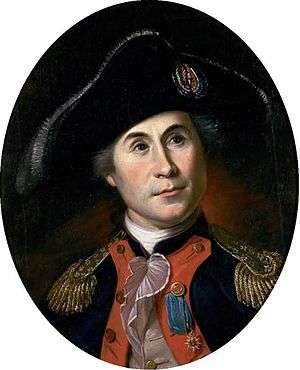Raid on Canso (1776)
| Raid on Canso (1776) | |||||||
|---|---|---|---|---|---|---|---|
| Part of the American Revolutionary War | |||||||
 John Paul Jones | |||||||
| |||||||
| Belligerents | |||||||
|
|
| ||||||
| Commanders and leaders | |||||||
|
|
George Smith (merchant)(POW)[1] | ||||||
| Strength | |||||||
| 2 brigs | approximately 15 fishing vessels | ||||||
| Casualties and losses | |||||||
| none | 1st attack: 3 vessels burned, 1 sunk, 5 prizes, 1 shallop confiscated; 2nd attack: 6 prizes, 1 burned, 1 confiscated | ||||||
The Raid on Canso took place on 22 September – November 22, 1776 during the American Revolutionary War. The raid involved John Paul Jones attacking Canso, Nova Scotia and the surrounding fishing villages. [2][3]
Background
During the American Revolution, Americans regularly attacked Nova Scotia by land and sea. American privateers devastated the maritime economy by raiding many of the coastal communities,[4] such as the numerous raids on Liverpool and on Annapolis Royal.[5]
During the American Revolution, Canso was subject to numerous raids by American Privateers. George Washington's Marblehead Regiment raided Charlottetown, Prince Edward Island on 17 November 1775 and three days later, they raided Canso Harbor.
Raid
On September 22, 1776, Canso was attacked by American privateer John Paul Jones. The privateer sailed on the USS Providence and destroyed fifteen vessels, and damaged much property on shore. There he recruited men to fill the vacancies created by manning his prizes, burned a British fishing schooner, sank a second, and captured a third besides a shallop which he used as a tender.[6] [7][8]
Jones then pillaged the community of Petit-de-Grat and Arichat on Isle Madame, Nova Scotia. The nine ships (300 men) immediately surrendered. On the evening of September 25, a gale droved three of the prizes on to shore and they were destroyed. (The remaining prizes were Alexander, Kingston Packet, Success and Defence.) Jones destroyed John Robin’s fishing business when they plundered and razed the entire establishment. The business of John Robin ended and he did not return until after the war.[9] Jones then sailed to Boston only to return two months later.
On 22 November, John Paul Jones returned to Canso in the USS Alfred. Boats from the ship went ashore and he raided the community, his crews burned a transport bound for Canada with provisions and a warehouse full of whale oil, besides capturing a small schooner. He took 6 prizes, 1 burned, 1 confiscated.[10]
Captain Jones then went on to present-day Sydney, Nova Scotia to free 300 Americans imprisoned in the British coalmines.[11][12]
Aftermath
Again in 1779, American privateers destroyed the Canso fisheries, worth $50,000 a year to England.[13]
American privateers remained a threat to Nova Scotian ports for the rest of the war. For example, after a failed attempt to raid Chester, Nova Scotia, American privateers struck again in the Raid on Lunenburg in 1782.
See also
Notes
- ↑ Guys borough sketches and other essays. p. 102
- ↑ John Paul Jones Raids Arichat, 1776
- ↑ John Paul Jones: A Sailor's Biography by Samuel Eliot Morison, 1959
- ↑ Benjamin Franklin also engaged France in the war, which meant that many of the privateers were also from France.
- ↑ Roger Marsters (2004). Bold Privateers: Terror, Plunder and Profit on Canada's Atlantic Coast" , p. 87-89
- ↑ John Paul Jones: A Sailor's Biography by Samuel Eliot Morison, 1959
- ↑ p.60
- ↑ pp.77-78
- ↑ John Paul Jones Raids Arichat, 1776
- ↑ John Paul Jones: A Sailor's Biography by Samuel Eliot Morison, 1959
- ↑ Jones' log book
- ↑ p.63
- ↑ Lieutenant Governor Sir Richard Hughes states in a dispatch to Lord Germaine
References
Primary Sources
Secondary Sources
- John Brebner. The Neutral Yankees of Nova Scotia. Columbia University. 1937.
- John Paul Jones: A Sailor's Biography by Samuel Eliot Morison, 1959
- John Paul Jones Raids Arichat, 1776
- John Dewar Faibisy. Privateering and Piracy: The Effects of New England Raiding Upon Nova Scotia During the American Revolution, 1775-1883. University of Massachusetts. 1972. pp. 41-44
- William Bell Clark, George Washington’s Navy (Baton Rouge: Louisina State University Press, 1960, Chapters 5, 7.
- Gardner W. Allen, A NAVAL HISTORY OF THE AMERICAN REVOLUTION (Boston, 1913), Chapter 17.
- Gwyn, Julian, Ashore and afloat
- Gwyn, Julian (2004), Frigates and Foremasts: The North American Squadron in Nova Scotia. Waters, 1745–1815, UBC Press.
- John Reid, Maurice Basque, Elizabeth Mancke, Barry Moody, Geoffrey Plank, and William Wicken. 2004. The 'Conquest' of Acadia, 1710: Imperial, Colonial, an Aboriginal Constructions. University of Toronto Press.
- Guysborough Sketches and Essays.
.jpg)